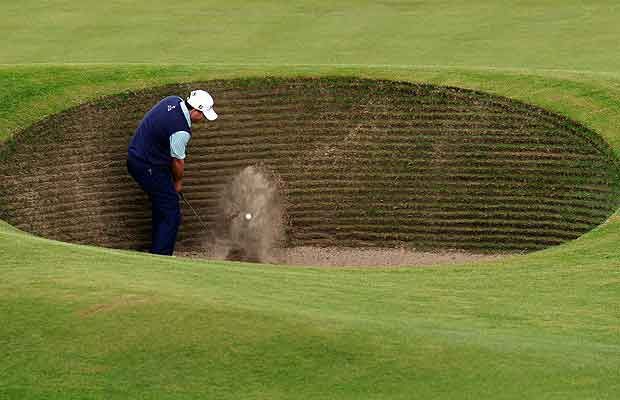By Mike May
Have you ever been in the Lion’s Mouth, visited The Coffins or been to Hell? If not, then you have yet to have played golf at the historic Old Course at St. Andrews in Scotland.
The Old Course will be the site of this year’s 150th edition of the Open Championship, July 14-17. While many golf courses name their holes, St. Andrews also names their bunkers. With over 100 bunkers, the players in the OPEN Championship will need to show their best bunker skills. The unique names include, Shell, Strath, Road Hole, The Principal’s Nose, The Spectacles, The Coffins, Lion’s Mouth, and Hell. If you successfully navigate the deep traps at St. Andrews, which appear on 16 of the holes, you also must avoid the Swilcan Burn on the 1st hole and the Valley of Sin at the 18th hole.
On all golf courses, bunkers are a hazard, but at St. Andrews, the bunkers take center-stage because the course’s biggest defense are the bunkers and the wind.
The bunkers at St. Andrews range in size from the miniscule pot bunkers to the massive Hell bunker on the 14th hole. While the Hell bunker is the biggest sand trap on the course, six-and-a-half feet deep covering more than 300 square yards it takes a back seat to more famous and feared, The Road Hole bunker. This severe test of golf protects the front of the 17th green and is responsible for ruining many golfers dreams of hoisting the Claret Jug.
In 1933, Gene Sarazen was competing in the Open Championship at the Old Course at St. Andrews. In one of the rounds, Sarazen’s ball landed in Hell bunker. By the time he holed out at the 14th green, he had a triple bogey eight and missed being in a playoff for the Open Championship by one shot.
At the 1978 Open Championship, the Road Hole bunker reared its ugly head and ruined Tommy Nakajima’s chances of a win. He was tied for the lead in the third round as he teed off on the 17th hole. After reaching the green in two, Nakajima’s first putt rolled off the green and found the Road Hole bunker. Four shots later he made it back on the green and finished with a quintuple-bogey nine. The Road Hole bunker earned a new nickname that day, ‘The Sands of Nakajima.’
The Spectacles are two pot bunkers situated about 60 yards short of the putting surface on the fifth hole. The Spectacles are dastardly deep cesspools and are virtually identical.
The toughest par three at the Old Course is the 11th hole is made more difficult by the presence of the Shell and Strath bunkers, which protect the entrance to the green. Tee shots that land in the Shell bunker require a long bunker shot to the green. Plugged lies are also common in the Strath bunker and can sometimes result in an unplayable lie.
In the middle of the 13th fairway, just under 300 yards from the tee sit the three Coffin bunkers. They are situated side-by-side across the fairway and any player landing in them will not be able to reach the green in two shots
Any player avoiding The Coffins must next negotiate the Lion’s Mouth bunker which guards the green.
The 16th hole is best played up the right side of the fairway, but out-of-bounds lingers nearby, as do the three Principal’s Nose pot bunkers. Just past the Principal’s Nose, resides another diabolic sand trap, Deacon’s Sime, which is named after a local preacher who played many rounds at the Old Course during his life. The preacher noted that the bunker should be named after him, upon his death because he spent so much time in that bunker while alive, he had his ashes deposited there to spend eternity in that hazard.
It’s fair to say that when playing the Old Course at St. Andrews, the best way to remember the bunkers is to avoid hitting into them. In other words, they are best seen, but not experienced.
Any player that will hold the Claret Jug this year will need to successfully navigate the many bunkers at the Old Course.










